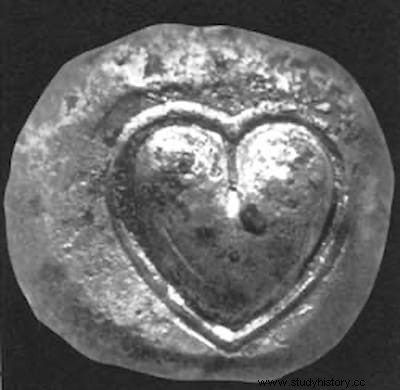The ancient Greek city of Cyrene (in present-day Libya), where Eratosthenes was born, was founded by colonists from Thera (Santorini) following the advice of the Oracle of Delphi around 632 BC. It soon prospered and became one of the richest cities in the Mediterranean.
A plant, whose trade Cyrene dominated for centuries, had a lot to do with it. It was his main product, of such importance in the economy of the city that even the coins carried his image. They called it Silphius (Σίλφιον) and the first reference to its habitat is given by Herodotus:
Its use began in prehistory and spread throughout all Mediterranean cultures, to the point that both Egyptians and Minoans had a specific symbol or glyph for it in their writing systems. It was used as a food seasoning, perfume, aphrodisiac and medicine. The Romans called it laserpicio for its sap, delicious to taste and smell, and they considered it as valuable as gold and silver.

Its stems were eaten roasted or boiled, its roots fresh in vinegar, and if it was fed to sheep, its meat was extremely tender. Its flowers were grated as a condiment for all kinds of food. As a medicine it was a panacea that served almost everything. Pliny the Elder says that it was good against hemorrhoids, animal bites and wounds in general. As an aphrodisiac, it may have been the first effective contraceptive in history, and the heart-shaped seeds are believed to be the reason this symbol is associated with love.

The problem is that today nobody knows what plant the silphium was. We know it because ancient authors mentioned it very often in their works, mainly the Romans. It is known that Julius Caesar kept about 680 kilograms of it in the official treasury of the city of Rome. But just over a century after his death, Pliny the Elder wrote that only one stalk had been found in Cyrene during his lifetime, uprooted and sent to the Emperor Nero sometime between AD 54 and 68.
Pliny goes on to say that for a long time silphium was no longer brought from Cyrene, but from Persia, Media or Armenia, where it grew in considerable abundance, but much less than that of Cyrene. Also that the quality left much to be desired, as it arrived adulterated with rubber or mashed beans.

Most specialists believe that the plant became extinct, in fact Pliny (who never saw it) says that it was wild and impossible to cultivate, because if it was tried, it would leave the land desolate and sterile . He also indicates how to recognize it:
However, most experts believe that this is an absurd story that Pliny must have invented, who knows why. But the fact is that by the middle of the 1st century AD. the silphium had practically disappeared. The main reason could be the overexploitation since Cyrenaica became a Roman senatorial province, and the abandonment of the previous strict control over its collection.

Despite descriptions of the plant by Theophrastus and other ancient authors, and numerous representations on Cyrene coins, silphium has never been satisfactorily identified.
One of the current theories is that the silphium was a natural hybrid, and so when the Greeks tried to grow it from seed the result may have been barely recognizable. Many hybrid plants grow not from seed but asexually by spreading their roots, and the second generation can be quite different from the original.

In any case, not many studies have been carried out on the diversity of the flora in Libya, so some experts believe that the silphium may still be there, hidden in some remote place, the only problem is that nobody knows what exactly it is. what are you looking for. The most accurate description is that of Theophrastus:
Theophrastus compared silphium with the asafetida splint (probably the silphium that Pliny said was brought from Persia) that grew in Syria and on the slopes of Parnassus, assimilating both to fennel. Scientists believe that the shots may go that way, that the silphium may be the same as the asafetida, a variety of ferrule, plants that grow as weeds in North Africa. One of these plants, the ferula tingitana , still exists in Libya. It is what most experts believe to be the silphium.
But there is more, because the historian Flavio Arriano, who wrote his Anábasis de Alexander Magno in the 2nd century AD says this when recounting how Alexander crossed the Hindu Kush (which the Romans called the Indian Caucasus):

About 200 years before Alexander ventured into those places, a good part of the population of the Cyrenaic city of Barca had been deported by the Persians to Bactria. Could it be possible that these barceans carried silphium seeds with them?:
In the early 1990s, the Italian archaeologist Antonio Manunta, from the University of Rome, found specimens of Cachrys ferulacea in Cyrenaica. , also known as common basilisk . The Bedouins of the area, who thought that it was the same plant as the silphium, took Manunta to a valley where it grew in abundance and where the silphium had supposedly flourished in ancient times. The archaeologist confirmed that the oil from the seeds of this plant has a pleasant smell, which coincides with Dioscorides' statement that the Libyan silphium did not have the strong smell of asafetida. According to Manunta, of all the plant seeds that have been proposed to be the silphium, this is the only one whose seeds are, like that one, heart-shaped.
However, doubts remain about this, mainly because Cachrys ferulacea is identical to the one the ancient Greeks knew as Magydaris , and the sources perfectly distinguish between it and the sylphium.
To this day, researchers continue to search for the silphium, convinced that it hides in plain sight and right under our noses.
